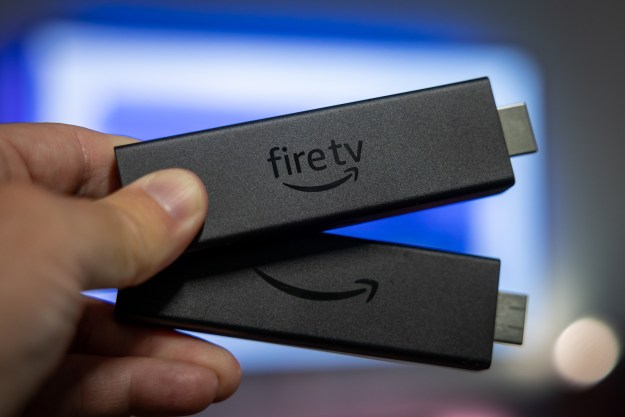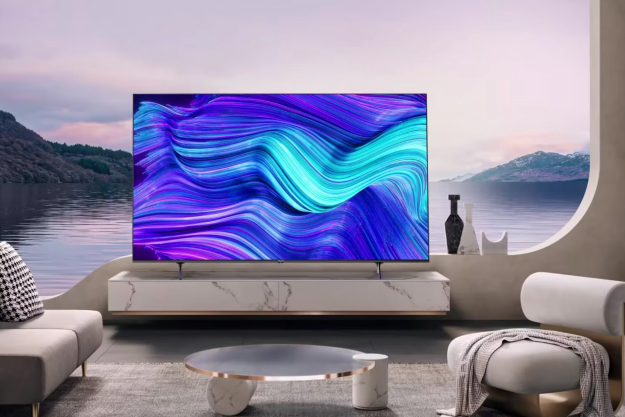When reviewing complex technology, it’s always tempting to fall back on the numbers — empirical data helps to make your point. And though data alone rarely tells the story in the highly subjective world of high-class headphones, there’s one number associated Shure’s new in-ear magnum opus, the KSE1500, that cannot be ignored: 3,000. As in dollars. That’s what it costs to put these innocuous-looking hunks of translucent plastic in your ears. Well, technically it’s $2,000 for the earphones, and $1,000 for the amplifier, but considering they’re co-dependent, that’s a moot point. Any way you cut it, $3,000 is an absolutely breath-stealing number.
However, focusing solely on the cost — while perfectly understandable for 99.999 percent of us — really does miss the point here. After eight years spent on research and development, jumping over multiple technical hurdles and training an unrelenting eye on sonic perfection, Shure has created something extraordinary in the KSE1500. That’s because the company decided to forego traditional in-ear driver designs for the complex (and downright vexing) technological challenge of micro-sizing electrostatic transduction.
Shure isn’t the first to the punch here, but squeezing electrostatic technology into a fully self-contained package of this shape and size is tantamount to cramming a rocket thruster under the hood of a ‘97 Honda Accord. And while the KSE1500 are priced for only the most ardent audiophiles, any headphone lover can appreciate their sonic achievements. The 1500 unearth a sound marked by unparalleled clarity and transient response above, while coaxing rich and ruddy layers of velvety warmth down below, placing these ‘phones among the most elite performers we’ve ever heard.
Out of the box
The KSE1500 come in a double-decker black matte container that looks something like a jewelry box you might get from Sharper Image. Removing the top reveals crystal clear ‘phones nestled in thick foam next to a jet-black amplifier — a spitting image of Shure’s SHA900 amplifier/DAC on the exterior, but with a Batman-approved color scheme.
Pulling out the bottom chamber reveals a gauntlet of accessories needed to flex the KSE1500 to fit almost any application: four types of eartips in multiple sizes, both short and extended 3.5mm cables, microUSB connectors for USB, Android, and iOS devices, a volume control attachment, dual heavy-gauge rubber bands to secure the amp to your phone, a 12-volt power supply, and finally, a snazzy leather carrying case.
The goods
We eluded to the wild world of electrostatic drivers in the intro, but let’s do a crash-course review for those who aren’t yet intimate with the technology: Most in-ear headphones use one of two driver technologies: dynamic drivers, which are essentially micro-sized versions of the speakers in your home, or balanced armature drivers, which are extremely tiny tubes (armatures) wrapped in a voice coil that vibrates when electrified, again, creating sound.
Electrostatic drivers are a bit more elegant in design, composed of a razor-thin membrane suspended between two electrified plates that use static electricity (hence the name) to create sound waves. The tiny variations in voltage which make dynamic drivers and balanced armatures work isn’t enough to drive them, so the signal must be highly amplified in order to move the membrane by voltage alone — hence the KSE1500’s dedicated amplifier, which applies up to 200 volts of power.
Squeezing electrostatic tech in earphones this size is like cramming a rocket thruster into a ‘97 Honda Accord.
And that’s just one of the features that make the KSE1500 so special.
Shure claims the KSE1500 are the first ever “electrostatic sound isolating” earphones, capable of delivering a whopping 37 dB of ambient noise isolation. Indeed, with just a light twist of music, the headphones virtually erase the outside world, and even without sound, we can barely hear ourselves typing this article.
Then there’s the cable, which trades the traditional flat design of most electrostatic headphones for a round(ish) kevlar-reinforced coil that looks just like a typical headphone cable at the top. At the bottom, however, it ends in a proprietary 6-pin connector for use only with dedicated amps.
Don’t call it an amp, though, as the partner device is also a DAC with support for hi-res audio at up to 24bit/96kHz sourced from a Mac, PC, iOS, or Android device. Just like its twin, the SHA900, a double tap of the volume knob calls up features like an adjustable four-band EQ analog RMS limiter. In fact, Shure’s Global Product Management head, Sean Sullivan, told Digital Trends that the SHA900 was actually just an afterthought, constructed from the guts of the KSE1500’s multi-layered amp/DAC design. So there you go, trickle down technology in the same device generation.
As for those numbers we talked about up top, the headphones offer a claimed 10Hz-50kHz frequency response (that ought to do it), a max SPL of 113 dB, and a weight of just 44 grams (sans the amp/DAC, of course). The amp sports proprietary amplification, while the DAC portion employs a Cirrus Logic 4272 chipset. Battery power for the amp/DAC is estimated at 10 hours for an analog input and seven on a digital signal.
The sound
“Isolating” is a defining word for the KSE1500, and in more ways than one. Never before have we experienced such starkly delineated instrumentation across virtually every genre, apart, perhaps, from Sennheiser’s aforementioned Orpheus (priced at $50K). Vocals, saxophone, guitar, bass — you name it, each instrument is carved and polished, and the dust blown away to expose nothing less than its elemental recorded sound, and all the nuances that come along.
Each instrument is carved down and polished to expose its elemental recorded sound.
Throughout our audition, we were astounded by the little nuances we picked out, like the bubbling reed of a single saxophone covering the bottom third in a horn ensemble, or the subtle movements of a drummer’s stick in a far-flung hi-hat groove, revealing not only differences in velocity, but also pitch shifts in the cymbal itself. In fact, details can be almost too pronounced (not that we’re complaining) with the KSE1500. Nickel Creek’s Reasons Why is almost all finger slides, string clicks, and metallic grit towards the end of the tune, as the mandolin melody is almost overshadowed by the capture of every audible movement and breath.
Of course, when you’ve glided loftily above all mortal headphones, it’s good to have a counter-weight to balance yourself. Luckily, we have a pair of top-quality custom-molded in-ear monitors, the Ultimate Ears Pro $1,000 Reference Monitors, paired with Shure’s SHA900 headphone for a relatively balanced A/B comparison.
All things considered, the RM hold up well against the Shure — especially for the price — and are also significantly more comfortable being 3D printed specifically for our ears. On sound alone, though, Shure’s latest offer some real advantages. For one thing, as mentioned in the intro, the KSE1500 find an astonishing balance between reveling in the transients of the snappiest snare or the airy waves of shimmering cymbals, and glowing with the kind of warmth and body you’d expect from your favorite dynamic driver in the bass and lower midrange. The sound isn’t more boomy, or even bigger necessarily, but it is weightier, with more meat on the bone. The “flatly” sculpted sound of the RM comes off a bit cold at times in comparison, especially in the lower midrange.
The RM also have difficulty delivering the subtlest nuances of the instrumentation as readily and openly as the KSE1500. Take that hi-hat example mentioned earlier, which came from a 24bit/96kHz version of Steely Dan’s My Rival. While the RM definitely allowed for the same movements in the hi-hat to be perceived, it was as if I was farther away, zoomed out from the more minute delicacies. What’s more, the Shure offered a powdery glow to the cymbal puffs, while the RM’s rendering was again more cool and (ok, we’ll say it) a bit more clinical.
This is a serious point, as electrostatic headphones have traditionally been praised for their super-speedy transient response, yet maligned for their cold tone and weaker bass response. Shure’s Sullivan told us a big reason for that warmth is a happy accident that occurred when the electrostatic components were folded into the KSE1500’s tiny chamber. The close quarters create a physics anomaly that allowed the engineers to coax a smoother, fuller sounding low-frequency response. They were then able to tone down a bit of the snappiness up top, while still keeping the KSE1500’s clarity to expose the subtlest of details in the music.
That’s how Shure was able to work with a totally different technology and still keep its signature sound. And that’s pretty special.
Conclusion
There’s no denying that Shure’s KSE1500 are a lavish pair of in-ears that only the most enthusiastic — or downright nutty — audiophiles will seek out. While the in-ears themselves are portable, being chained to a dedicated amp means you’ll always have to budget some extra space.
But there is also no denying the KSE1500 represent a monumental breakthrough in headphone technology — one that may well yield very real benefits in the form of an entirely new generation of earphones we can all enjoy, stretching beyond the KSE1500’s own lifecycle.
In the end, while our reasoned mind says we’d never spend $3,000 on an in-ear headphone, our ears convey another message: Run out and buy these — right now.
Highs
- Breathtaking clarity
- Warm and rich sonic color
- Astonishing instrumental separation
- Effortlessly exposes subtle details
- Impressive passive noise isolation
Lows
- Not as comfortable as custom in-ears
- Requires specialized amplifier
- Prohibitively expensive





